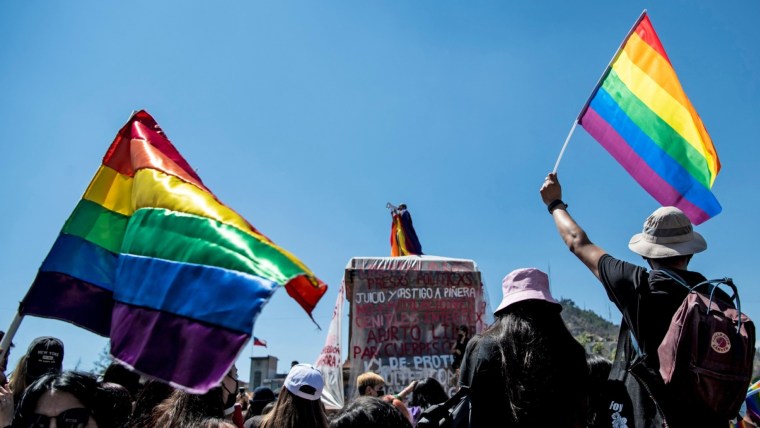Percentage of LGBTQ adults in U.S. has doubled over past decade, Gallup finds
The percent of U.S. adults who identify as something other than heterosexual has doubled over the last 10 years, from 3.5 percent in 2012 to 7.1 percent, according to a Gallup poll released Thursday.
Gallup found that the increase is due to ”high LGBT self-identification, particularly as bisexual, among Generation Z adults,” who are 18 to 25.
It asked more than 12,000 U.S. adults how they identify during telephone interviews last year. It found that younger U.S. adults are much more likely to identify as LGBTQ than older generations.
More than 1 in 5, or 21 percent, of Generation Z adults identify as LGBTQ, Gallup found. That’s almost double the proportion of millennials, who are 26 to 41, at 10.5 percent, and nearly five times the proportion of Generation X, who are 42 to 57, at 4.2 percent. Less than 3 percent of baby boomers, who are 58 to 76, identify as LGBTQ, compared to just 0.8 percent of traditionalists, who are 77 or older.https://iframe.nbcnews.com/u5fH2si?_showcaption=true&app=1
As the youngest Americans slowly outnumber and replace the oldest, Gallup predicts the number of LGBTQ-identifying adults will only increase — and likely at a much faster rate than past generations.
The poll found that the percent of Generation X, baby boomers and traditionalists who identify as queer has remained relatively the same over the years. More millennials have increasingly identified as LGBTQ, but only slightly, at 5.8 percent in 2012, 7.8 percent in 2017 and 10.5 percent now.
But the poll noted that the percentage of Generation Z adults who are queer has almost doubled since 2017 — jumping from 10.5 percent in 2017 to 20.8 percent. The rise shows that younger Gen Zers, who have turned 18 since 2017, are more likely than older Gen Zers to identify as queer.

Study shows Americans are becoming more understanding, accepting of LGBTQ community
Gallup noted that the youngest Gen Zers — who are as young as 10 — still haven’t turned 18, and they are even more likely to identify as LGBTQ.
If the trend of millennials and Generation Z increasingly identifying as LGBTQ continues, “the proportion of LGBT Americans should exceed 10 percent in the near future,” Gallup found.
Bisexuals make up 4 percent of all U.S. adults
Bisexuality is the most common identifier used among LGBTQ Americans, which is in line with a Gallup report released last year. More than half of LGBTQ Americans, at 57 percent, are bisexual.
Over one-fifth of LGBTQ respondents, or 21 percent, are gay, 14 percent are lesbian, 10 percent are transgender and 4 percent identify as something e
Overall, 4 percent of U.S. adults identify as bisexual, compared to 1 percent who identify as lesbian, 1.5 percent as gay, 0.7 percent as transgender and 0.3 percent as other. Heterosexuals comprised 86.3 percent of total respondents, and 6.6 percent did not offer an opinion.
Generation Z adults are the most likely to identify as bisexual, at 15 percent overall, compared to 6 percent of millennials and less than 2 percent of Generation X, baby boomers and traditionalists.
Increasing acceptance — in certain areas
Gallup notes that the proportion of Gen Z Americans who identify as LGBTQ is increasing at a faster pace than previous generations, and that they are growing up at a time when 70 percent of Americanssupport same-sex marriage rights, and a majority also support nondiscrimination protections for LGBTQ people.
But that support varies when broken down further. For example, Gallup’s annual Values and Beliefs survey found last year that 66 percent of people favor allowing openly transgender people to serve in the military, that figure is down slightly from its previous measure in 2019, when 71 percent were in favor.

How the ‘rainbow wave’ of LGBTQ+ politicians is changing political landscape
At the same time, 62 percent of Americans say trans athletes should only be allowed to play on sports teams that correspond with the sex they were assigned at birth, while 34 percent say they should be able to play on teams that match their gender identity, the survey found.
At the time, Mara Keisling, former executive director of the National Center for Transgender Equality, attributed that contrast at least in part to the wave of legislation in states seeking to bar trans students from competing on school sports teams that align with their gender identity.
But she also noted that — consistent with Gallup’s data — as more Americans know trans people and more young people identify as LGBTQ, acceptance will grow. As for those pushing anti-transgender legislation, she added, “Someday, they’ll be in the dustbin of history.”